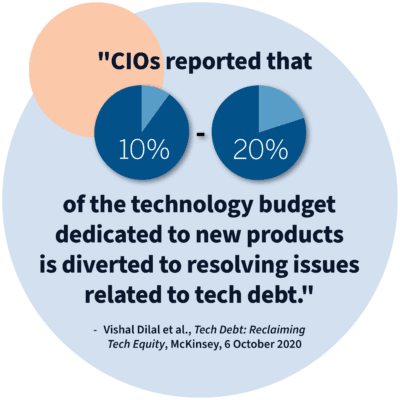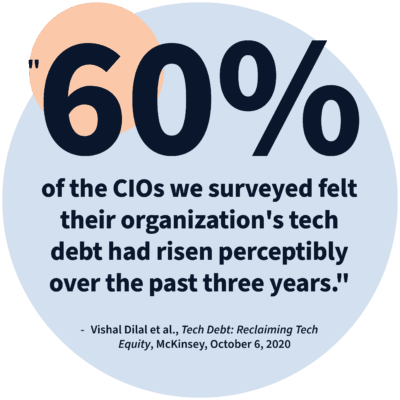When it comes to timely technology improvements, the price of doing nothing is high. Consider Southwest Airlines. After decades in the spotlight as the airline industry’s customer service darling, the culmination of circumstances—peak holiday bookings, nationwide foul-weather flight interruptions, and manual processes required by pilots/crew —revealed years of short-term decision making resulting in technology patches and quick fixes. And while those quick fixes papered over several system shortcomings for a time, each added to Southwest’s technical debt. When that technical debt came due, the price was staggering: the company’s reputation, the cost of reimbursing customers for canceled flights, overnight stays, and luggage location and delivery—and the eventual high cost (and high visibility) of investing in new technology under intense public pressure.

Is Tech Debt Plaguing My Enterprise?
The short answer? Most likely. Let’s bring things out of the headlines and into the everyday to show just how relevant, immediate, and universal the technical debt threat can be.
Consider an enterprise that chooses on-premises deployment of the core software solutions necessary for its day-to-day revenue and communications activity. While on-premises hosting may offer greater security and control—a belief now challenged by significant advances in cloud technology—it also comes with the added burden of maintaining both the on-premises system and the software necessary to serve its needs.
For a while, this approach may serve the objectives of our hypothetical company. But as the needs of the enterprise, its end-users, and customers evolve, so will the demands on the software. To avoid the cost of systemic upgrades, the enterprise will likely do what enterprises do: make a series of quick fixes; add a growing list of new, single-purpose applications; and by delaying the expansive, structural changes necessary to address the growing shortcomings of the core system and its software, the enterprise incurs steadily increasing levels of technical debt.
In contrast, today’s sophisticated cloud capabilities and SaaS software solutions eliminate the server infrastructure and software maintenance challenges associated with on-premises alternatives. Operating on a shared responsibility model, cloud deployments take the burden off, in-house teams. Operating on this model, cloud providers assume all responsibility for infrastructure upgrades and maintenance. SaaS software providers monitor software performance and field subscriber issues and automatically implement necessary fixes and upgrades to ensure the secure, consistent, and reliable operation of all software-dependent enterprise functions.
Data Ops: a Canary in the Coal Mine for Technical Debt?
As Southwest Airlines can confidently attest, compromised customer experience is often an early—and glaring—indicator of growing technical debt. Technology rarely ages gracefully. Over time, customer service issues increase when experience falls short of promise: flights are delayed, timelines lag, and interactions are frustrated by erroneous or outdated data.

In essence, a consistent growth in customer data at a specific moment that matters in the customer journey might offer a prompt to review systems and processes. By analyzing leading indicators to technical or process shortcomings, the enterprise can identify root causes—and use that information to make foundational fixes that don’t incur technical debt. When those fixes suggest systemic issues that don’t lend to meaningful short-term fixes with long-term benefits, it’s time to re-evaluate systems and lay the groundwork for more significant technology upgrades.
Which Industries are Particularly Vulnerable to Technical Debt?
When an industry is reliant on technology, it is susceptible to the hazards of technical debt. As enterprises scale, those concerns multiply—particularly in industries where data volume is high, data quality is critical, and customer experience and retention are make-or-break, such as:
- Financial services;
- Insurance;
- Healthcare;
- Pharmaceutical;
- Travel/hospitality;
- Government.
For those industries, technical debt can wreak havoc on:
1. Employee performance and retention
Absent a clear strategy to retire tech debt, those changes can create systems that lag, become poorly integrated, and create frustrating employee and customer experiences, with performance that can frustrate both end-users and customers. With so many competitors looking to attract your best employees and customers, this kind of short-term thinking will create churn you can’t afford.
2. Customer confidence
Whether you’re called on to engage with other businesses, individual consumers, patients, or constituents, your ability to know, serve and anticipate their needs is paramount to their confidence and your success. The short-term fixes that accrue tech debt erode those capabilities, compromise customer relationships, and put your enterprise at long-term risk.
3. Data compliance and security
Ad-hoc technology fixes rarely resolve systemic issues and are an open invitation for data security and compliance compromises.
4. Operational alignment and administration
The oversight and management of multi-location and remote workforces significantly increase demands on technology—and on their ability to perform uniformly and consistently. Technical debt threatens that alignment, putting enterprises at risk of inconsistent behaviors that can quickly create overwhelming, costly challenges.
How to avoid (and tackle) technical debt
When facing any challenge, including technical debt, knowledge is power. But power only makes a difference when it’s wisely applied and leveraged—which compels us to offer a few ways to avoid technical debt and, when it’s necessary, to minimize its long-term impacts. Here are a few places to start:

1. Enlist C-Suite support
CEOs often face the competing priority of satisfying shareholders with strong quarterly performance and maintaining technology to ensure smooth enterprise operations. But technology debt requires a deliberate approach to ongoing technology improvement and maintenance—typically involving investments that can hinder quarterly results but improve long-term performance. Because of that, tech debt remediation requires C-level discipline and commitment to succeed—even when it conflicts with quarterly performance.
2. Establish a shared definition of tech debt
To set a clear baseline, enterprises must arrive at a shared definition of technical debt before developing a strategy to address it. The definition may vary from one organization to another, but situations that compromise data integrity—including data quality and data trust—are nearly universal indicators of technical debt. Some tech debt is unavoidable—intermediate fixes are sometimes essential to continue operations, so it’s important to understand what’s acceptable and what triggers the need for major intervention.
3. Maintain a data council
In large organizations, application proliferation is one of the leading contributors to tech debt. Enterprise teams know their pain points and seek solutions that address them. Unfortunately, when multiple departments invest in multiple applications to solve individualized challenges, they increase integration burdens on IT—and add to the list of technologies that will eventually require updates or replacements. A data council develops and uses consistent protocols to ensure that all technology solutions are evaluated on the macro and micro levels. By evaluating solutions capable of addressing the needs of multiple teams, enterprises can reduce application bloat, maintain current technology inventories, and develop strategies to keep effective technologies current—or seek new alternatives.
4. Monitor KPI outputs & use data as a guide
Enterprises should routinely evaluate the performance of the technologies they use to gauge the quality of their output. Aligning technologies with OKRs and KPIs can help keep tech debt at bay – especially as customer data begins to signal that processes are failing. When your data flows are working well, the gears of your technology are working well. When data flows stall and quality erodes, the technology gears are rusty. That’s when data observability practices come in handy to identify impediments—and prioritize short and long-term solutions.
5. Don’t underestimate the complexity of creating your own solution
Custom-tailored software or data management solutions may seem like the best way to address the unique, idiosyncratic needs of a team or department. But in many cases, their useful working life is often short—while more refined, tested solutions are often designed for longer-term adaptability. It’s tempting to solve a seemingly small problem in house—but in doing so, you may overlook more complex issues that could have catastrophic implications if left unresolved.
6. Listen to end-users and customers
Because they use technologies and experience their impact daily, end-users and customers are often the first to experience technology shortcomings. By surveying them regularly, enterprises can gauge the real-world impacts of aging technology and processes and develop initiatives to change those falling short of their original promise.
Summary
As enterprises scale, some measure of technical debt is inevitable. No software, tech infrastructure investment, or hybrid or human process is perfect. Oftentimes, everyday operation exposes shortcomings and compromises that demand attention and support, but don’t justify the cost and commitment of systemic change. But enterprises can engage in careful planning before any implementation to present- and future-proof their tech and process investments, minimizing the need for the short-term fixes that incur technical debt. And when companies develop shared strategies to know when it’s time to fix—or time to upgrade—they go a long way toward avoiding levels of technical debt that simply can’t be repaid.
Recent Articles
- What is Agentforce? Salesforce’s AI Agents Explained
- Digital Transformation in Banking: Trends, Challenges, and Future Insights
- Three Key Takeaways from Dreamforce San Francisco 2024
- What is AI Copilot in CRM: Detailed Guide with Examples
- Building a Strong Network of Salesforce Professionals at the Nebraska Summit

